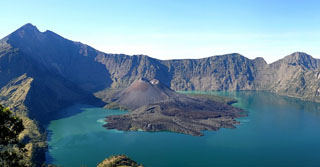Report on Rinjani (Indonesia) — 27 July-2 August 2016
Smithsonian Institution / US Geological Survey
Weekly Volcanic Activity Report, 27 July-2 August 2016
Managing Editor: Sally Sennert.
Please cite this report as:
Global Volcanism Program, 2016. Report on Rinjani (Indonesia) (Sennert, S, ed.). Weekly Volcanic Activity Report, 27 July-2 August 2016. Smithsonian Institution and US Geological Survey.
Rinjani
Indonesia
8.42°S, 116.47°E; summit elev. 3726 m
All times are local (unless otherwise noted)
Based on satellite and pilot observations, the Darwin VAAC reported that an eruption at Rinjani on 1 August generated an ash plume that rose to an altitude of 9.8 km (32,000 ft) a.s.l. and drifted S. Ash plumes were first visible in satellite images at 1150, and according to PVMBG passengers aboard a plane noted that ash plumes rose 2 km above the crater. BNPB noted that the Lombok International Airport closed at 1655 and was scheduled to reopen at 1000 the next day. Later on 1 August ash plumes rose to altitudes of 4.3-6.1 km (14,000-20,000 ft) a.s.l. and drifted S, SW, and W. No plumes were visible at 1730; conditions had returned to normal levels although BNPB warned that the public should stay at least 1.5 km away from the volcano.
Geological Summary. Rinjani volcano on the island of Lombok rises to 3726 m, second in height among Indonesian volcanoes only to Sumatra's Kerinci volcano. Rinjani has a steep-sided conical profile when viewed from the east, but the west side of the compound volcano is truncated by the 6 x 8.5 km, oval-shaped Segara Anak (Samalas) caldera. The caldera formed during one of the largest Holocene eruptions globally in 1257 CE, which truncated Samalas stratovolcano. The western half of the caldera contains a 230-m-deep lake whose crescentic form results from growth of the post-caldera cone Barujari at the east end of the caldera. Historical eruptions dating back to 1847 have been restricted to Barujari cone and consist of moderate explosive activity and occasional lava flows that have entered Segara Anak lake.
Sources: Darwin Volcanic Ash Advisory Centre (VAAC), Badan Nacional Penanggulangan Bencana (BNPB), Pusat Vulkanologi dan Mitigasi Bencana Geologi (PVMBG, also known as CVGHM)

